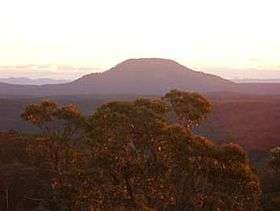Baiame

In Australian Aboriginal mythology Baiame (Baayami or Baayama or Byamee) was the Creator God and Sky Father[1] in the dreaming of several language groups (e.g. Kamilaroi, Eora, Darkinjung, and Wiradjuri), of Indigenous Australians of south-east Australia.
Description and history


The Baiame myth tells how Baiame came down from the sky to the land, and created rivers, mountains, and forests. He then gave the people their laws of life, traditions, songs, and culture. He also created the first initiation site. This is known as a bora; a place where boys were initiated into manhood. When he had finished, he returned to the sky, and people called him the Sky Hero or All Father or Sky Father.[2]
He is said to be married to Birrahgnooloo (Birran-gnulu), who is often identified as an emu, and with whom he has a son Daramulum (Dharramalan). In other stories Daramulum is said to be brother to Baiame.
It was forbidden to mention or talk about the name of Baiame publicly. Women were not allowed to see drawings of Baiame nor approach Baiame sites—which are often male initiation sites (boras).
In rock paintings Baiame is often depicted as a human figure with a large head-dress or hairstyle, with lines of footsteps nearby. He is always painted in front view; Daramulum is drawn in profile. Baiame is often shown with internal decorations such as waistbands, vertical lines running down the body, bands and dots.
Link with the Christian God
The missionary William Ridley adopted the name of Baiame for the Christian God when translating into Gamilaraay (the language of the Kamilaroi). It is sometimes suggested that Baiame was a construct of early Christian missionaries. Doubt is cast on this by a reference to Baiame apparently dating back to 1830-1840 by K Langloh Parker.[3]
Portrayal in the Lake Macquarie Area
In the area surrounding Lake Macquarie in New South Wales, Australia,[4][5] he was believed to have created all of the mountains, lakes, rivers and caves in the area. After he finished creating, he jumped back up to the spirit world from Mount Yengo, which he flattened. Its flat top can still be seen to this day, near Wollombi Valley.[6] A cave near Milbrodale contains many wonnarua Aboriginal paintings, including a large figure of a man who may be Baiame. It is popularly known as the Baiame Cave and is part of a series of rock shelters on an area of 80 hectares. The site is listed on the Register of the National Estate.[7] It depicts him with enormous, long, arms and large staring eyes.
Significance
During the Stolen Generation many tribes lost information about their culture, traditional beliefs, stories and ceremonies, and because Aboriginal customs were not written down and recorded, the effect of the Stolen Generation affected all. To the several local tribes, the Wiradjuri, Darkinjung, Wonnarua, Awabakal, Worimi, Biripi, Wailwan and Kamilaroi, it is another piece to the puzzle, helping them uncover lost ceremonies and traditions.
See also
References
- ↑ Aboriginal Art of Australia, Baglin (Mulavon) 1986, p.11
- ↑ "Footprints on Rock", 1997, Sydney: Metropolitan Local Aboriginal Land Council. ISBN 0-7313-1002-0
- ↑ Parker, K. Langloh (1905). "The All Father, Byamee". The Euahlayi Tribe: A Study of Aboriginal Life in Australia (1 ed.). London: Archibald Constable and Company. pp. 4–10.
- ↑ Wright.T- Belongs the Kamilaroi people
- ↑ Yengo National Park
- ↑ Wollombi Valley History
- ↑ The Heritage of Australia, Macmillan Company, 1981, p.2/211
External links
![]() Media related to Hunter Valley at Wikimedia Commons
Media related to Hunter Valley at Wikimedia Commons